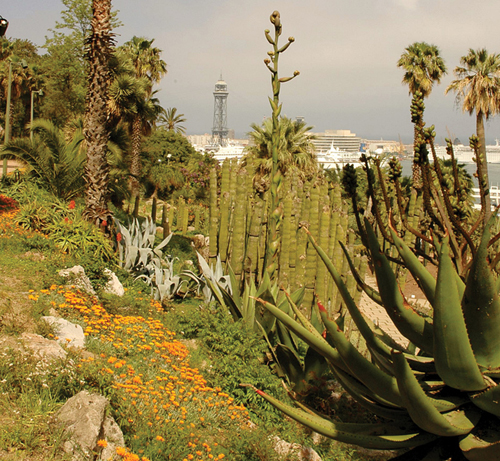Montjuïc
Named the “Jewish Mountain”, after an important Jewish cemetery that existed here in the Middle Ages, this sizeable and mountainous park rises 213 m (700 ft) above the port. The park itself was first landscaped for the 1929 International Exhibition, when the elegant Palau Nacional and the strikingly modern Mies van der Rohe Pavilion were also built. During the following decade, the area fell into general disuse and soon became synonymous with decline. Together with the grim shadow cast over the hill by the castle, which for years acted as a slaughterhouse for Franco’s firing squads, it is little short of miraculous that Montjuïc is now one of Barcelona’s biggest tourist draws. However, as the main site for the 1992 Olympics, held on its southern slopes, Montjuïc was given a comprehensive face-lift and the area was transformed into a beautiful green oasis, with two fabulous art museums and a host of stunning sports facilities. All these elements are interconnected by a network of exterior escalators and interlaced with quiet, shady gardens, which offer dazzling views over Barcelona and a welcome respite from the bustle of the city.

|
NOTE
You can board the Montjuïc Bus Turístic (see Tours & Trips), which ferries visitors up the hill from Plaça d’Espanya and back (April to October).
NOTE
Palau Nacional & Museu Nacional d’Art de Catalunya
The Palau Nacional is home to the Museu Nacional d’Art de Catalunya which exhibits Catalonia’s historic art collections. Boasting one of Europe’s finest displays of Romanesque art, the museum includes a series of breathtaking, 12th-century frescoes, rescued from Catalan Pyrenean churches and painstakingly reassembled in a series of galleries here. See Museu Nacional d’Art de Catalunya.
Palau Nacional
Fundació Joan Miró
One of Catalonia’s most representative painters, Joan Miró (1893–1983), donated many of the 11,000 works held by the museum. Housed in a stark, white building designed by his friend, architect Josep Lluís Sert, the collection – the world’s most complete array of Miro’s work – was recently extended to include 25 new pieces by him. See Fundació Joan Miró.

Font Màgica
Below the cascades and fountains that splash down from the regal Palau Nacional is the Magic Fountain, designed by Carles Buigas for the International Exhibition of 1929. As darkness descends, countless jets of water are choreographed in a mesmerizing sound and light show. When the water meets in a single jet it can soar to 15m (50ft). The extravagant finale is often accompanied by a recording of Freddie Mercury and Montserrat Caballé singing the anthem Barcelona as the fountain fades from pink to green and back to white before silently and gracefully disappearing.
Av de la Reina Maria Cristina
May–Sep: every 30 minutes 9:30–11:30pm Thu–Sun; Oct–Apr: every 30 minutes 7–8:30pm Fri & Sat
Free
DA
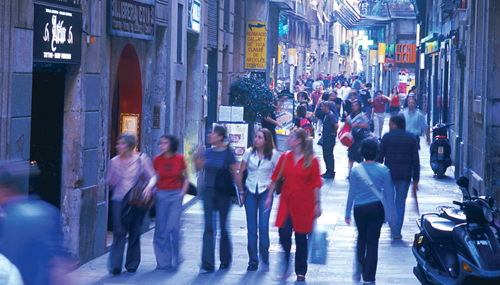
Castell de Montjuïc
Dominating Montjuïc’s hill, this gloomy castle was once a prison and torture centre for political prisoners. At the end of the Spanish Civil War, 4,000 Catalan nationalists and republicans were shot in the nearby Fossar de la Pedrera, now a grassy field overlooked by thick stone walls. After such a tragic history, the castle is entering a happier phase: it is being developed into an international peace centre, but visitors can still climb the sturdy bastions for superb views of the port below.
C/Castell
Open Tue–Sun
Free
Statue, Castell de Montjuïc
Castell de Montjuïc
Estadi Olímpic
The Olympic Stadium was first built for the 1936 Workers’ Olympics, which were cancelled with the outbreak of the Spanish Civil War (see 1936-1975: Civil War & Franco). Today, the original Neo-Classical façade is still in place, though the stadium was entirely rebuilt for the 1992 Olympic Games. It is home to Espanyol football team (see FC Barcelona Football). The nearby Museu Olímpic i de l’Esport is a modern interactive museum dedicated to all aspects of sport.
Av de l’Estadi
Open 10am–6pm (to 8pm Apr–Sep) Tue–Sat, 10am–2pm Sun
Adm
DA
Estadi Olímpic
Teatre Grec
This beautiful, open-air amphitheatre (see Swimming) was inspired by the Classical ideas of what was known as Noucentisme. This late 19th-century architectural movement was a reaction to the overly-decorative nature of Modernisme. With its leafy, green backdrop and beautiful gardens, there are few places more enchanting than this to watch Swan Lake or listen to some jazz. The theatre is used for shows during the summertime Festival del Grec (see Teatre Grec), when it also becomes home to a luxurious outdoor restaurant.
Pg Santa Madrona
10am– dusk
Free (when there are no shows)
Palau Sant Jordi
The star of all the Olympic installations is this steel-and-glass indoor stadium (see Palau Sant Jordi) designed by Japanese architect Arata Isozaki. Holding around 17,000 people, the stadium is the home of the city’s basketball team (see FC Barcelona Basketball). The esplanade – a surreal forest of concrete and metal pillars – was designed by Aiko Isozaki, Arata’s wife. Further down the hill are the indoor and outdoor Bernat Picornell Olympic pools (see Swimming); both open to the public.
Av de l’Estadi
Open 10am–6pm (to 8pm May–Sep) Sat & Sun
Free
DA
Palau Sant Jordi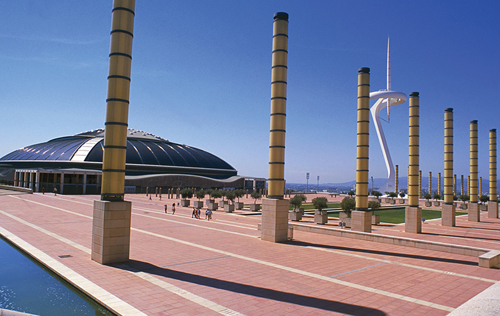
Pavelló Mies van der Rohe
You might wonder exactly what this box-like pavilion of stone, marble, onyx and glass is doing bang in the middle of Montjuïc’s monumental architecture. Years ahead of its time, this surprisingly rationalist gem represents Germany’s contribution to the 1929 Exhibition. Built by Ludwig Mies van der Rohe (1886–1969), the elegant pavilion was soon demolished, only to be reconstructed in 1986. Inside, the elegant sculpture Morning by Georg Kolbe (1877–1947) is reflected in a small lake.
Av Marquès de Comillas
Open 10am–8pm daily
Adm
Barcelona Chairs, Pavelló Mies van der Rohe
Poble Espanyol
This Spanish poble (village) has been recreated from a hotchpotch of scaled-down famous buildings and streets from around Spain. Although a bit tacky, it has become a centre for arts and crafts, including an impressive glass-blowers’ workshop. There are restaurants and cafés aplenty, and a couple of trendy nightclubs (see La Terrrazza).
Av Marquès de Comillas
Open 9am–8pm Mon, 9am–2pm Tue–Thu, 9am–4am Fri, 9am–5pm Sat, 9am–midnight Sun
Adm
Poble Espanyol
Caixa Forum
The Fundació La Caixa’s impressive collection of contemporary art is housed in a former textile factory, designed by Modernista architect Puig i Cadafalch. The collection began in 1985 and assembles some 800 works by Spanish and foreign artists, which are shown in rotation along with temporary international exhibitions.
Av Marquès de Comillas
Open 10am–8pm Tue–Sun
Free
DA
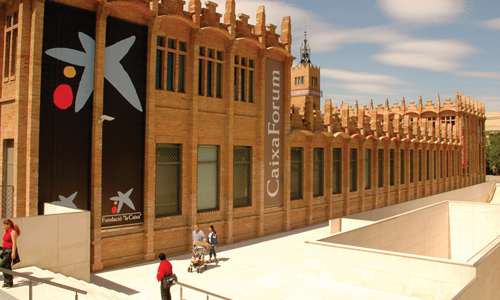
A Day in Montjuïc
Morning
To get to the Fundació Joan Miró before the crowds and with energy to spare, hop on the funicular from Parallel metro station. From here it is a short walk to the museum, where you’ll need an hour and a half to absorb the impressive collection of Miró paintings, sketches and sculptures. When you’ve had your fill of contemporary art, refuel with a cafè amb llet on the restaurant terrace before backtracking along Av de Miramar and jumping on the cable car up to Castell de Montjuïc . Wander the castle gardens and look out over the city and the bustling docks. Return to Av de Miramar by cable car and follow the signs to the Palau Nacional , where you can lunch on typical Catalan cuisine with a modern twist in the elegant Oluem.
Afternoon
Afterwards, spend an hour perusing the MNAC ‘s extraordinary Romanesque art collection. When you exit, turn right and then follow the signs to the Olympic complex. The Estadi Olímpic is worth a look, but the silver-domed Palau Sant Jordi steals the limelight. Nearby, at Bernat Picornell, spend the late afternoon cooling down with a dip in the fantastic open-air pool. If it’s summer, there may even be a film showing. From here it is just a short stroll to the Poble Espanyol where you can settle in at a terrace bar in Plaça de Mayor and sip a cuba libre as night descends.
Parks & Gardens
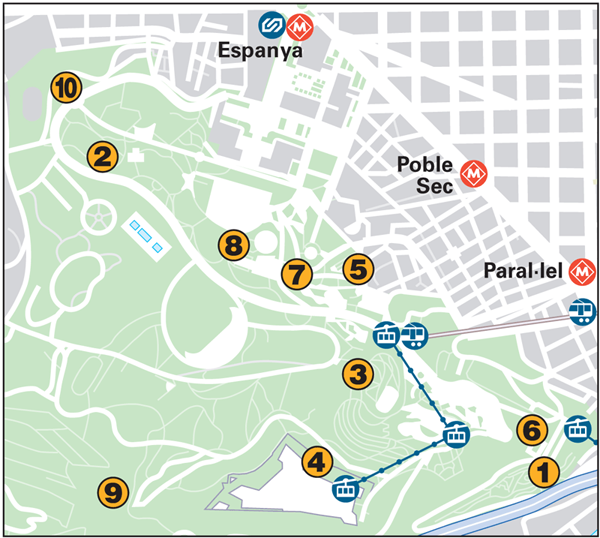
Jardins del Teatre Grec
Reminiscent of the Hanging Gardens of Babylon, this gracious oasis surrounding the Greek amphitheatre is officially known as La Rosadela.
Jardins de Miramar
Opposite the Miramar, these gardens are scattered with stairways leading to enchanting leafy groves with vistas.
Jardins Laribal
This multi-level park hides a small Modernista house, by Puig i Cadafalch, and the Font del Gat – a drinking fountain, which has inspired many local songs.
Jardins de Joan Maragall
An avenue lined with sculptures by Frederic Marès and Ernest Maragall is the main delight here. The garden also has the last of the city’s ginjoler trees.
Open 10am–3pm Sat & Sun
Muntanya de Montjuïc
A multitude of secret paths leads through wild gardens on Montjuïc’s south side, the only part of the mountain that remains untamed.
El Mirador del Llobregat
A viewing area with small gardens nearby, this is the only place in the city where you can see the plains of the Llobregat stretching below.
DA
|
Restaurants, Cafés, Bars & Clubs

Oleum
Dine on refined Mediterranean cuisine under the dome of the Palau Nacional and enjoy amazing views across the city.
Palau Nacional
93 289 06 79
Closed Mon, eves
DA
Brasería Cañota
Cañota’s superb, traditional, and supremely economical cooking includes excellent game dishes and chargrilled fresh fish and meats.
C/Lleida 7
93 325 91 71
DA
Fundació Joan Miró Restaurant
A great terrace, views of Miró’s sculptures, plus well-presented modern food with an Italian accent.
Parc de Montjuïc
93 329 07 68
Closed eve
DA
Rias de Galicia
A giant aquarium is full of lobster, crabs and more, all waiting to be plucked out and served up sizzling on a plate.
C/Lleida 9
93 424 81 52
La Tomaquera
A neighbourhood classic that serves Catalan home cooking at bargain prices. Arrive early or be prepared to queue.
C/Margarit 58
Closed dinner Sun, Mon, Aug, Easter week
El Lliure
The Lliure theatre has a good-value café with an adjoining restaurant. In summer there are tables on the terrace.
Passeig Santa Madrona 40-46
Closed Mon eve, Sat lunch, Sun
La Terrrazza
Techno music rules at one of Barcelona’s most popular nightclubs, housed in a Balearic-style mansion inside the Poble Espanyol.
Poble Espanyol
Closed Sun, mid-Oct–mid-Jun
Adm
Restaurant Forestier
Located in the AC Miramar, this elegant restaurant has wonderful views over the harbour and city.
Pl. Carlos Ibáñez, 3
93 281 16 00
Quimet & Quimet
This tiny bodega has standing room only, but serves tasty tapas and wonderful wines.
C/Poeta Cabanyes
93 442 31 42
Closed Sat eve, Sun, Aug
|


